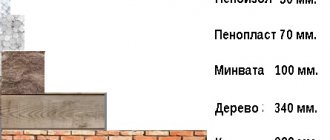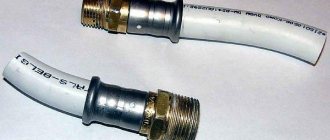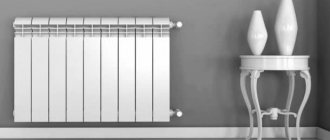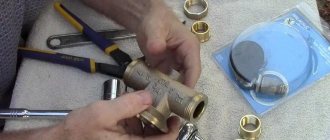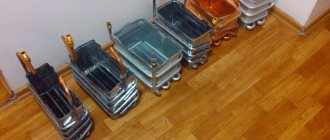Thread sealant is designed to make gas, heating or plumbing pipe connections as tight as possible. When choosing a suitable option, you should take into account all the features of thread sealants, navigate among the whole variety of types, keep in mind both old-fashioned sealing methods and the use of modern anaerobic gels.
Peculiarities
When undertaking a major overhaul, many people think about the tightness of the pipes as the last thing, but in vain. After all, it depends on how high the probability is that everything could be ruined by an unexpectedly occurring leak. This is especially true when pipes run close to expensive equipment: the damage to the family budget will be more than noticeable. However, many find the simplest solutions, using improvised means to seal the thread: tow, threads, plasticine. All this does not provide the necessary insulation. And now it’s time to pay special attention to professional thread sealants.
Professional materials include fum tapes, Teflon threads and anaerobic gels. It is worth dwelling on the latter in more detail. They have recently been used more often than others, as they provide an optimal level of adhesion to pipes, completely sealing the threads. Properly applied anaerobic sealant can withstand pressure of 50 atmospheres, not to mention vibration loads. In general, such a sealant is the best choice for household use, and it will work just as well on professional sites.
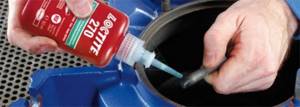
The main feature of anaerobic gel is that it begins to harden only when the nut or connection is tightened and the air access to the sealant is blocked. As a result, the connection turns out to be, one might say, monolithic, and practically no mechanical effort can break it. Only ultra-high temperatures help, which can only be achieved using special tools (for example, a hair dryer). It is safe to say that heating pipes can also be sealed using gel, and the durability of the joints will be excellent despite temperature changes.
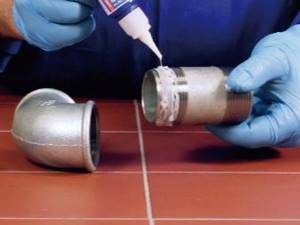
If you apply anaerobic gel according to all the rules, it will last for 5 years or longer. If the technology has not been properly followed, then the guaranteed service life will be only a year. However, even a one-year warranty is more than you can expect when using unprofessional products and materials. Many people complain that anaerobic binders are too expensive (the average price varies from 1,500 to 2,000 rubles per 50 ml tube), but practice shows that such sealants are worth the money, because repairs if something happens will cost much more. In addition, the gel is economical, and it is quite possible that such a tube will be enough to seal all the plumbing and communication pipes in the apartment.
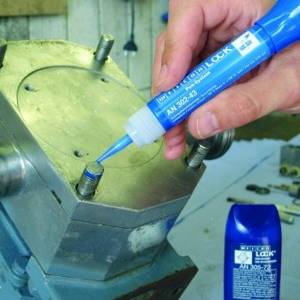
Thus, we can say with confidence that anaerobic sealants owe their popularity precisely to their characteristics.
How to seal threaded heating connections
7.1. Gaskets
Many people use end gaskets to seal heating pipes. This method is technologically the fastest, but the quality of sealing could be better.
The thing is that during assembly of the structure, the gasket is strongly pressed by the thread and the joint density may suffer slightly, since the part opposite to the external thread has a slight narrowing.
But to make the joint tighter and more reliable, they use a paronite or fluoroplastic part, after installation of which the entire structure must be securely screwed together. Although it is not always possible to achieve transitions without narrowing with this method.
Taking this into account, a gasket is often installed when sealing sensors and instruments for measuring pressure or temperature, where the hydraulic resistance is not very large. True, experienced plumbers, for greater confidence and reliability, use additional sealing in the form of, for example, tow with red lead. They explain this by saying that we are still dealing with hot water, which is not always safe.
7.2. FUM tape
Since the coefficient of friction of the fluoroplastic tape is low, it can be used to assemble an entire threaded structure without much effort. The advantages of the material include high chemical resistance and long service life.
Like all materials, FUM tape has some disadvantages:
- during the assembly process it can tear into separate pieces, or be twisted back out;
- cannot be used in connections with possible temperature deformations. The fact is that the tape has poor adhesion to metal, and if the joint “plays”, the seal may be squeezed out;
- can act as a reliable sealant for threaded connections with a diameter of only up to 25 mm. Therefore, using such material it is impossible to completely install a heating system.
7.3. Tow
This simple and cheap material has been a reliable sealant for decades. For impregnation, lead minium on drying oil or ordinary oil paint are most often used.
Despite the emergence of good modern sealants, flax strands have been and remain the leader among the most reliable sealants. Due to its positive qualities, the material is often used in the installation or repair of heating systems.

- reliability;
- seal quality;
- cheapness;
- ease of use.
The disadvantages include:
- limited service life;
- tendency to dry out;
- the need to have certain skills in winding and coating.
Kinds
Based on their base, anaerobic sealants are divided into those whose composition is based on an oligomer, and those based on polymers of the acrylic group. Both have similar qualities: they can withstand high pressure, are not subject to the negative influence of mechanical loads, and so on. The difference is important only for professional chemists; construction specialists do not pay attention to this parameter when choosing.
It is much more important to separate sealants according to the degree of fixation. There are options for strong fixation, medium (universal) and low.

Low degree fixing agents are used when it is necessary to seal a small diameter pipe connection. The clamp does not tolerate vibrations and fluctuations, and the pipe itself can be easily untwisted using available tools. This makes the use of low-fix sealant an excellent choice when you need to connect pipes only temporarily, and you plan to dismantle them in the near future. This type can also be used for long-term use, but provided that during operation there will be no significant loads on the threaded connection.

Medium hold pastes and gels are most often used in everyday life. They are suitable for sealing heating systems, gas pipelines, water supply systems, and their use is absolutely harmless and does not change the quality of drinking water. That is why sealants of this type are called universal. They firmly fix the thread, but the joint can be dismantled in the future, only for this it will be necessary to use specialized equipment. The clamp can withstand the loads generated by batteries, water supply pipes and plumbing fixtures.
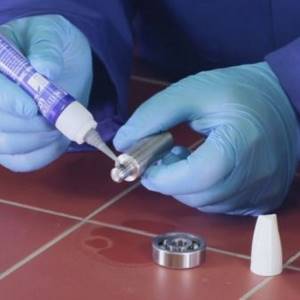
Strong fixation is not needed at home. Such sealants seal the pipes forever and further dismantling is impossible. They are usually used in industrial production: plants, factories, and in the construction of the city sewer network. These clamps are much more expensive than household ones and require special knowledge and skills when working with them, because you will have to act quickly and accurately. The connection is inextricable and in the future, if necessary, the joint will have to be sawn.
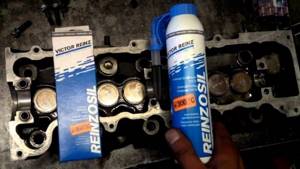
Frequently used medium-fix sealants are also classified. In this case, the classification category is the degree of viscosity of the drug. The smaller and more frequent the threads, the thinner the sealant must be so that it can optimally fill the entire air space of the joint. The maximum diameter of pipes for which anaerobic gels and pastes are produced is 4 cm. Large pipes are sealed in other ways.

Linen thread
Using flax thread is the oldest method of sealing threads.
The only advantage of this product is its low price and constant availability. Even if no other sealants are on sale, flax thread will definitely be available. But the material has a great many disadvantages:
- Difficult to install on threads. If you don't have the skill, you're unlikely to get it right the first time. If a mistake is made during winding, such a joint will quickly unwind, nullifying all your efforts.
- Small operating temperature range. Linen threads practically do not tolerate heat, so they cannot be used to insulate batteries and radiators. They will quickly collapse, leading to leakage.
- Hydrophilicity. Linen thread absorbs moisture well, as a result of which it swells greatly during operation. This may cause the pipe connection to burst. Similar cases are possible when we are talking about pipes made of fragile materials, such as aluminum. However, flax thread is still used to insulate those pipes through which water does not flow.
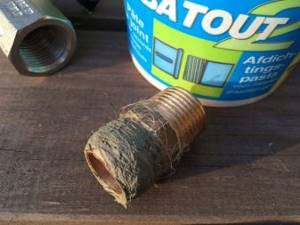
Teflon or plumber's thread
Teflon or plumbing threads are in many ways similar to flax threads. In the same way, there is a need for correct winding, but this is the only drawback they inherited from their natural “predecessor”.
Teflon threads are impregnated with special compounds that make them universal. They function well both when insulating water pipes, gas pipes and others. Compared to the previous case, the plumbing thread guarantees a good fit and does not fall apart for a long time. It can withstand high temperatures without anything happening to it.
Teflon threads are absolutely safe. They do not release anything into the pipeline, so they are suitable for use on drinking water pipes. However, it is better to clarify this point further.
Some cheap samples are intended purely for technical use.

FUM tape
FUM tape is one of the most popular options, as it is easy to use and has a low cost. All you have to do is wrap a piece of tape around the threads and then tighten the nut or fitting tightly.
However, this is not the main advantage of the tape. It does not affect the thread. If other materials fall apart or stick, then the FUM tape can be easily removed completely by simply unscrewing the thread. At the same time, the tape is completely safe and is excellent for sealing water pipes.
Unfortunately, the tape cannot fix the connection, as they say, tightly. Vibrations or mechanical stress will weaken the joint until a leak inevitably appears. The only means of prevention is to periodically tighten the nuts. Due to this drawback, it should not be used to seal joints on those pipes through which water flows under high pressure.
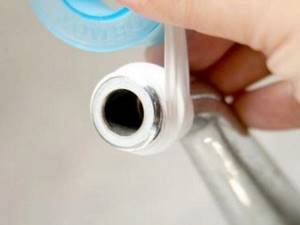
Non-hardening
This type is relatively new for the Russian consumer. These compounds are produced in the form of a paste, with which you need to thoroughly process the thread, and then simply tighten the nut. It’s also easy to unwind it in the future.
The viscous substance does not glue the pipes together, but simply fills cracks and gaps, preventing water from leaking out. The composition is absolutely harmless to humans, so such sealants can be used in plumbing work.
Do not use sealant paste in cases where the water supply is under high pressure. Then the water will displace the sealant and a leak will form. Unfortunately, there are no means of prevention here, so you will simply have to refuse to use such a remedy, choosing some other, more suitable option.
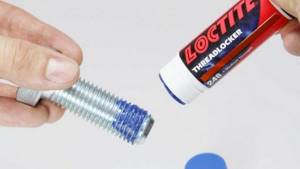
Hardening
Such substances have high strength characteristics. The fixative sealant takes a long time to dry. Time may vary significantly from manufacturer to manufacturer. However, this is the only drawback of such products.
After applying and tightening this sealant, you must wait the time indicated on the packaging before starting testing and active use. This is especially true when water is supplied under high pressure. It is worth noting that the sealant tolerates prolonged exposure to water under high pressure, since it is almost impossible to displace it after it has dried.
There are products on the market with certain degrees of fixation.
It depends on the degree exactly how, if necessary, you will have to untwist the pipe: simply apply more force or break it.
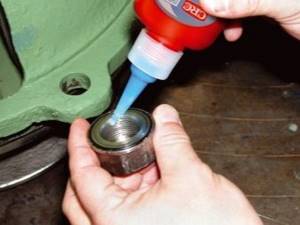
Anaerobic
Today, anaerobic fixatives are the latest development, quickly gaining recognition. They are suitable for use by both amateurs and craftsmen. Sold in convenient 250 ml tubes and suitable for long-term storage.
The operating principle of anaerobic sealant is as follows. In the open air, it retains a liquid consistency, so it can be easily applied to the thread without fear that it will “set” ahead of time. After the nut is tightened, a chemical process begins, the sealant crystallizes, turning into plastic glue and making the joint completely monolithic. The full reaction time takes no more than 3 hours, after which full operation can begin.
Dismantling is carried out using heat: you need to thoroughly heat the joint, after which you can unscrew the nut.
This method does not work with strong-hold sealants.
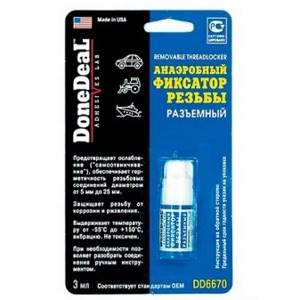
Sealing gel
Thread sealants from this category are rarely used in everyday life. Basically, they have found application in the automotive industry, since it is convenient for car enthusiasts to carry sealant in the form of a gel with them, so that, if necessary, they can quickly fix a broken part.
The main purpose of gels is not sealing, but strengthening joints. They make them more durable and resistant to vibration and mechanical stress. This is why many people encounter such difficulties when naively trying to unscrew any bolt on the engine: even at the factory they are treated with a sealing gel.
The only way to deal with a joint treated with such a product is to heat it well.
Otherwise, you may waste your energy without achieving the desired result.
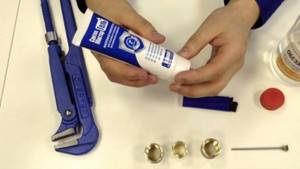
Fum tape for sealing
FUM tape is the thinnest polymer sheet (from 0.08 to 0.12 millimeters thick), capable of sealing even the smallest gap and not preventing the screwing of any thread (even with very precise dimensions and almost complete absence of tolerances).
This is a suitable option not only for laying plumbing systems, but also for installing precision measuring instruments for heating or water supply.
The application technique is simple and does not require any specific skill - the main thing is to follow a few simple rules:
- Use only a clean surface that is free of any chemically active substances or solid particles that could damage the thread seal used and affect its properties.
- Apply slight tension to the fum tape when winding to ensure increased density.
- Avoid twisting the tape.
- Do not allow it to break. This applies both to winding and to the subsequent screwing of metal parts.
- Lay turns of FUM tape with slight overlap over the entire expected length of the threaded connection.
If compaction is insufficient, then it is necessary to increase the thickness of the layer. In difficult situations, it is necessary to select the layer thickness experimentally. The obvious advantage of fum tape is that the joint is instantly ready for work - there is no need to wait a certain amount of time, as with water supply sealant.
Immediately after the work is completed, the plumbing fixtures can be used to their full potential.
When disassembling the joint, for its subsequent connection, the procedure for winding the tape is repeated. In addition to plumbing, FUM tape is also suitable for sealing gas pipes. For industrial applications, it is necessary to ensure that the gas does not pose a risk to the polymer structure and that the pressure is moderate. Overall, this is one of the most versatile products.
Sealing thread for sealing
A relatively new approach to thread sealing involves winding a special polymer thread around the external thread. Thanks to its structure, it stretches well, does not tangle and fits securely to the metal base.
It also has the property of elasticity, that is, when compressed, it tends to return to shape and therefore reliably fills the space between the internal and external threads.
When sealing plumbing, it is important to follow a number of rules: winding clockwise and from the outer edge, ensuring the required number of layers. Laying is done along the threaded recesses - it is better not to rush, and place it carefully and evenly. As with the tape option, you can increase the number of layers to better fill the gap.
There are several types of standard sealing thread:
- Polyamide. This sealing thread can withstand temperatures up to one hundred thirty degrees and pressure up to sixteen atmospheres. This is more than enough for household use, and it is what can most often be found in specialized stores.
- Fluoroplastic. This type of thread is already able to survive cooling or heating up to one hundred and fifty degrees (both plus and minus). It is also important to note the permissible pressure of thirty atmospheres and good resistance to chemical attack. Such seals are used for difficult conditions, and in ordinary life you should not resort to unjustified expenses, even for heating.
Watch video: sealing threads with anaerobic adhesive sealant
Anaerobic adhesive sealant
When choosing a sealing thread for plumbing, it is advisable to consider well-known brands and not try to save money at the expense of quality. It is worth noting that the packaging is convenient - it is presented in the form of a reel. This is convenient for applying and storing the tape; it will not get tangled and laying occurs smoothly.
We use polymer gaskets
Almost all plumbing devices are equipped with polymer gaskets: faucets, connecting hoses, filters, etc. The good old rubber has been replaced by a wider range of products, which have improved properties and do not require local adjustment.
The sealing ring for threaded connections has a number of useful properties:
- A fairly robust design that can withstand dozens of atmospheres.
- Low cost and retail sale. This is the cheapest option compared to sealant, glue or FUM tape
- Suitable for large end gaps - up to one millimeter. There are many options when, for example, using a tap thread is technically difficult and irrational.
- An assortment designed for different types of plumbing fixtures. They are often sold in kits, allowing you to choose the optimal design.
- Possibility of reconnection without additional surface preparation. It is not recommended to perform this action frequently - with constant compression, the structure of the product deteriorates, as a result, the reliability of the joint is called into question.
- Possibility of increasing functionality. For example, when installing faucets, it is wise to install rings with coarse mesh filters at the junction points, which will retain mechanical impurities and avoid clogging in the future.

The downside is the limited use for plumbing threaded connections - there are many configurations of heating or plumbing systems in which there is simply nothing for the ring-shaped gasket to rest against.
The installation technology is as follows:
- Make sure that the seal itself has no external damage and corresponds to the installation location. This applies to both the external and internal diameters (reducing the bore hole is not recommended).
- Check the installation site, which must not be dirty.
- Carefully assemble and tighten the threaded connection. Tighten with a wrench. This method does not require significant force to avoid deformation of the gasket.
Important! If everything is done correctly, then applying additional sealant to the thread itself is not required.
In case of leaks after connection, it is usually sufficient to tighten the nut. If this does not help, it means that the gasket is defective or was chosen incorrectly. Over time, replacement may be required due to wear or damage to the structure of the polymer product.
Colors
The most important criterion by which one can immediately draw a conclusion about what the sealant is used for and what properties it has is color. Anaerobic thread sealants are produced in several colors.
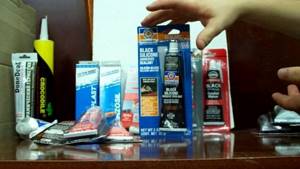
Blue
Typically, blue anaerobic sealants are only suitable for metal pipes and parts. The joint turns out to be resistant to all kinds of influences, be it water, gas, antifreeze, gasoline and the like. The blue retainer is a high-quality seal that has only recently begun to be used in domestic conditions. Previously, it was only available in industrial production, for example, in the construction of defense structures, rockets, and spaceships. Application is limited only by the diameter of the pipes: it should not exceed two centimeters. Dismantling can be carried out without special equipment by applying medium mechanical forces.
Red
Red sealants are needed to seal worn, worn out threads. Red sealants are also used to seal joints of ferrous metal pipes. Red fasteners set faster than others, but this does not in any way affect their strength properties. They are resistant to high pressure and temperature changes. The diameter of the pipes that can be sealed with this anaerobic gel is no more than 3 cm. Dismantling will necessarily require heating the joint. When repairing, it is not necessary to remove excess sealant from the threads; you can apply a new layer directly on top of them.

Green
Green sealant is a low-strength variety. It is suitable for temporary connections of both plastic and metal pipes. When dismantling it, no effort will be required: it will be enough to unscrew the connection as usual. Manufacturers claim that the difference between the blue and green options is small, but this is not the case. Blue is resistant to all kinds of influences and vibrations, which cannot be said about green. The green sealant can be used to seal pipes up to 3.81 cm (1.5 inches) in diameter. The important point is that the threads must not be damaged.
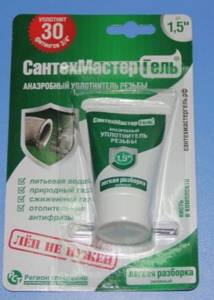
Sealing with other materials
In addition to the above-mentioned seals, the following are often used for sealing:
- epoxy resin. It is clear that the principle of its operation is the same as that of the glue of the same name produced on its basis. this substance is used to connect the risers of the sewer system;
- Portland cement. With its help, more than one sealing mixture is produced, which, in combination with asbestos rope, is used to caulk socket joints of pipes of a cast iron sewer system;
- petroleum bitumen or asphalt mastic. These substances are very effective in cases where it is necessary to seal ceramic or cast iron sockets;
- technical sulfur. When using this substance, sealing cast iron joints and similar sockets is almost ideal.
They are mounted on pipelines, car windows, and house windows. Such products are excellent waterproofers and sealants. They can also be used in the form of shock-absorbing materials.
For their manufacture, special rubber is used, which is highly resistant to oils, gasoline, water, and high temperatures.
On those pipelines where oil and gasoline products are transported, you can often find the NT 42-75/7 seal, which is distinguished by its hardness, high heat resistance, and reliability.
Purpose of thread sealant
Sealants for threaded connections are constantly being improved, new products with improved characteristics are appearing to ensure high-quality sealing of pipes for a long time. Without sealing around the joints, there is a high risk of leakage, which is why choosing the appropriate sealant is of utmost importance.
Undesirable phenomena cannot be prevented solely by washers and strong tightening. Threads and tapes are often used for sealing; their task is only to seal; they cannot protect against negative influence factors. It is being replaced by modern thread adhesive in the form of gels and anaerobic compounds.
Plumbing thread
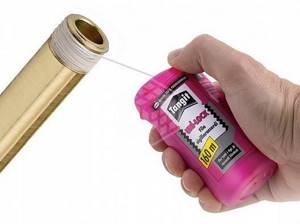
Sealing threads with plumbing thread
Plumbing thread is an excellent winding material for pipes with one drawback: its high price. It cannot be torn by hand and is suitable for sealing all threaded joints (even those that have a torn surface from a bad thread cutting tool). As for plastic parts, the tightening torque required when using threads is not the same as when using flax. Plumbing thread can be used for all parts.
Characteristic properties
To work with sealant, you need to know its characteristic features. This will allow you to choose exactly the composition that is suitable in a particular case.
All sealants differ in the following technical features:
- Fluidity or viscosity. For sealing small joints, mixtures in the form of a paste are best suited. When you need to seal a large seam, then you should use a liquid sealant. The greater the width, the thinner the composition. The mixture will flow into all gaps, completely sealing the joint.
- The strength or force required to separate a joint. Maximum fixation sealants cannot be unscrewed, you will only have to break them. A low-strength composition will allow you to do this with little effort. With medium fixation, you can unscrew it using additional tools.
- Temperature, that is, the maximum limit that the composition can withstand without losing its properties. It varies greatly for different sealants. Most compounds can withstand from -50 to +150 degrees. For extremely low and high temperatures, you need to buy a specialized thread sealant.
- Hardening speed. It is usually indicated on the packaging of the sealant. The rate of hardening depends on many factors, including the quality of the composition itself and the conditions under which sealing is carried out. The pipes can be used after this period has expired, otherwise depressurization will occur.
- Scope of use. There are many sealants available, but not all are suitable for water pipes or pipes that carry gas. It is necessary to select a mixture in accordance with the possibility of its use for individual jobs.
How to seal a threaded connection of plastic pipes
Household plumbing consists of many detachable threaded connections that must be securely sealed. High-quality sealing is the protection of a house and apartment from floods, damaged furniture, and scandals with neighbors. Not only professionals and amateurs, but also plumbers with different approaches to this, in general, simple work, argue among themselves on the topic of how and how to seal threaded connections of water pipes.

Let's evaluate the pros and cons of popular water pipe sealants and try to find the best one.
TOP 4 sealants for water pipes
Even those who have only been to a hardware store once are familiar with this list. After all, as soon as you turn to the seller for help in selecting a sealant, he voices these “names”: • Flax • FUM tape • Plumbing thread • Anaerobic sealants
Experienced craftsmen always have the entire set at hand. One sealant is good for temporary connections, the second quickly eliminates leaks, and the third is optimal for complex, inaccessible connections. Is there a universal one? Let's try to figure it out.
Plumbing linen
A classic sealant used in plumbing for decades. Available, cheap, familiar. Available in the form of skeins or braids of different weights. To wind flax, several strands of a certain thickness and length are separated from a common skein, twisted into a thread if necessary, and applied to the thread as the twist progresses. It is difficult to say exactly how much flax will be needed for a particular carving. And therein lies its first drawback. To assemble a high-quality connection the first time, you need experience and serious practice. Otherwise, you have to do everything by eye and spend time assembling/disassembling several connections.
Advantages of flax • Low price • Environmentally friendly • Reliable seal during the shelf life of the connection • Wide distribution and availability in any region • Permission for use in domestic plumbing and drinking water systems

Cons • Flax is an organic fiber, prone to biodegradation, rotting, swelling • Short warranty period - up to 5 years • Not the simplest winding technology - flax can slip on the thread, go beyond the limits, dangle, tear when winding. In addition, you need to have experience to understand how many turns to make - will one part screw onto another, will there be any backlash? • Pressure limitation - flax is effective in systems with pressure up to 8 atmospheres. For modern multi-storey buildings this indicator is no longer relevant. It definitely won’t withstand water hammer or just a pressure surge in the system.
To enhance the sealing properties of flax, use a special lubricant - oil paint, silicone sealant, plumbing paste. The latter shows good results, protects the thread from corrosion, makes twisting on flax pliable, and prevents rotting. The technology is this: first, flax is wound on the thread, then paste is coated on top. And only then the connection is assembled. Everything is simple, but the question arises - why do double work? And one more thing - when you buy a pair of flax/paste, the “cheapest sealant” ceases to be so.
Linen shows itself well as a temporary sealant for pipes and a means for simple connections located in direct visibility and open access.
FUM tape
PTFE sealing material - FUM - quite successfully competes with flax in terms of price and availability for any consumer. FUM is presented in every hardware store. It is a tape in reels of predominantly white color. The release form already suggests that FUM is much more convenient to use. At least, with this sealant you can work more carefully and without flax “hair” sticking out everywhere.
However, winding FUM tape using technology is no easier than sanitary flax. You need to know how to lay the tape correctly, how to fill each turn and how many windings to make. By the way, leaks in water supply systems at FUM occur precisely because of improper winding. Each connection requires its own portion of the attention and perseverance of the master - you need to make sure that the tape is engaged, does not tear, does not move, and only then twist the connection and secure it with a key.
Pros • Modern packaging and release form • Corrosion resistance • Non-toxic • Use on metal and plastic, thin and small threads
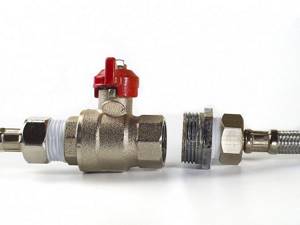
Disadvantages • Low reliability of the tape - it often breaks during winding and inside the thread • Requirements for threads - likes new, clean threads without burrs and other defects • It is impossible to adjust, i.e. untwist at an angle without loss of tightness • Large, uneconomical consumption - which negates the talk about the low price of FUM • High-quality tape costs an order of magnitude higher than ordinary tape, which is prone to rupture and without sufficient impregnation • Not used in conditions of elevated temperatures
FUM is indispensable as an alternative to rubber gaskets and sealing rings. Also suitable for temporary connections and for connecting (replacing) faucets or shower hoses.
Plumbing thread
A modern and most convenient sealant for threaded connections of water pipes. It is produced in small boxes equipped with a cutter, which eliminates the use of additional tools during the winding process. To assemble a water pipe from scratch or replace one section, you only need thread and threaded parts. The market also offers thread with replaceable spools. When purchasing one unit, it is enough to periodically replace the coil with a new one and continue using it without replacing the packaging or overpaying for it.
The thread is convenient, does not require any experience, and is provided with detailed instructions with pictures. Effective in water supply, sewerage, gas supply systems; for connecting household, plumbing appliances and equipment.
Advantages of the thread • It has a completely synthetic composition, which means it is not afraid of moisture and high temperatures - it does not dry out or swell • It is impregnated with a special sealing compound in production, i.e. does not require additional preparation - the product is ready for use immediately after opening the package • Does not impose requirements on threads - works with wet, old, contaminated threads without loss of protective properties • Simple and understandable even for a beginner winding technology - crosswise on threaded protrusions • Resistant to temperature and pressure changes - withstands pressure 2-3 higher than flax and FUM • Forms reliable but quick-dismountable connections • It is possible to adjust and dismantle • Seals connections on metal and plastic pipes
Advantages and disadvantages
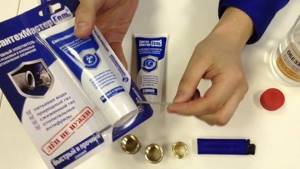
Each type of thread sealing has its pros and cons. Previously, threads and FUM tape were actively used for this purpose, but now they are significantly inferior to modern sealants. And there are many reasons for this.
Benefits of using thread sealant:
- Preservation of properties during temperature fluctuations. Does not affect the quality of sealing.
- Resistance to mechanical influence factors. It will not be possible to unscrew the nut without effort; to do this you will have to make an effort or use additional tools. This is an important condition, because water passing under pressure creates vibrations, which cause gradual unwinding.
- Penetration into hard-to-reach areas. The mixture fills all the cracks, the parts fit tightly to each other, creating complete tightness.
- Ease of use. Anyone can figure out thread sealants. They come with detailed instructions and tips.
- Low consumption. Use sealants sparingly; you only need a small amount of the compound to treat several pipes. For example, one bottle is enough for an average apartment.
But we should also dwell on some of the disadvantages of using sealing compounds. Such a plus as reliable grip turns into a minus when it is necessary to carry out repair work and uncouple the pipes. After using a high-strength sealant, the only way to disconnect is by breaking. Price also matters. The use of sealants will be more expensive than traditional thread sealing options.
Sealants are not suitable when repairs need to be carried out quickly, restoring the operation of pipes as soon as possible. The system can only be used after the mixture has completely hardened. There are not many disadvantages to sealants; they are becoming increasingly popular.
Sealing paste

Paste is the easiest way to seal threads. A special hardening or non-hardening paste made from synthetic resins with oils and other fillers.
Application of sealing paste
The sealing paste is used for threaded connections of water and gas pipelines , for systems with a non-aggressive environment .
Characteristics of sealing paste
Divided into hardening and non-hardening paste.
Hardening paste
- Withstands temperatures up to 210°C without sanitary flax, and up to 140°C with the use of flax.
- Pressure for gaseous phases up to 20 atm and up to 100 atm for water . The listed characteristics begin to operate after complete hardening. The time for complete hardening ranges from several minutes to several hours, depending on the manufacturer and the ambient temperature.
- Maximum pipe diameter 3 inches.
Non-hardening paste
- Suitable for use in lines with low pressure of liquids and gases.
- Not used for systems with aggressive environments .
- Shows the greatest effectiveness in combination with tow .
- Withstands up to 135°C.
Advantages of sealing paste
For hardening paste:
- High-quality seals the connection.
- Easy to use.
- Can be used for high pressure systems .
For non-hardening paste:
- Easy to use.
- Protects the joint from corrosion
- Possibility to easily dismantle the connection.
- Immediately after installation it is ready for use.
Disadvantages of sealing paste
For hardening paste:
- shrinks after drying .
- Once cured there is no possibility of adjustment.
For non-hardening paste:
- Cannot be used in aggressive environments.
- Suitable for systems with low pressure or no pressure at all.
How to use sealing paste
Before using sealant, the threads should be degreased and dried . Apply the paste evenly to both parts of the connection and mount immediately (this is especially true for hardening paste). For non-hardening paste, it is possible to use tow.
Manufacturers of sealing paste
- Russia MasterProf . Russian manufacturer of seals.
- Europe Unipak. A very popular company producing various types of seals.
- China Viscotex . Chinese company producing sealing paste.
Application area
Thread sealant is used in many areas of human activity. It is used to seal water pipes in apartments and private houses. But such materials are not suitable for insulating street pipes due to the fact that they have large diameters. Also, sealant for threaded connections of water supply pipes can be used for joints of sewer pipes.
In plumbing, a special plumbing compound is used. Its feature is resistance to temperature changes. This is especially important when connecting a washing machine. But, at the same time, the material should be selected so that it has adhesion to the plastic, otherwise special activators will have to be used.
To seal threads in heating systems, a composition that is resistant to temperature changes is also needed. Gas pipelines should use materials that are resistant to aggressive environments.
Thread sealants are also used in machine tool industry, automotive industry, aviation, water transport, medicine, construction, etc.
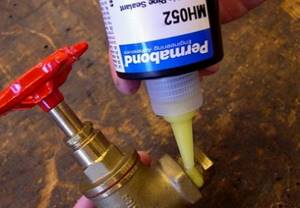
How to choose
If it is necessary to seal a threaded connection, it is better to use an anaerobic sealant. When using such a material, a number of conditions must be met for the best sealing.
Connection assembly time
The time required for high-quality assembly of a threaded connection is affected by the material of the thread and the coating to which the mixture must be applied. Materials differ in their tendency to polymerize. The sealant contacts active metals such as copper or aluminum quickly, and a high-quality connection is obtained in a short period of time. The seal contacts a little worse with chrome parts and composites. It adheres worst to galvanized and painted surfaces, as well as titanium and stainless steel.
When connecting two weakly contacting materials, forced heating is required for a reliable connection. If the connection occurs between an active metal and a less active one, then the hardening time of the paste will be the same as that of the less active material. For standard plumbing sealants and some automotive sealants, the time for complete sealing is indicated on the product packaging.
Necessary sealing conditions
Sealants vary in the temperature conditions in which they can be used. There are seals that can be used at high temperatures. Others, on the contrary, can be used in cold conditions. The special chemical formula of some types of sealants allows them to be used in unfavorable environments, high acidity or strong oxidizing agents. To work in heating systems, with gasoline and diesel fuel vapors, anaerobic materials are used.
Packaging form
The shape of the package plays an important role when applying the paste to the surface. For a variety of purposes, both packaging with a wide neck and, conversely, with a narrow neck are used. The sealant, located in a container with a wide outlet, is convenient for applying the composition to threaded connections. Such a hole allows you to completely envelop the threaded surface, filling all the necessary grooves.
Some types of seals are placed in a special cylinder, from which it is released using a gun. The device allows you to use the material more economically by adjusting the thickness of the composition exiting the cylinder. The gel-like material does not spread over the surface to be joined, which also allows the operation to be performed with the greatest savings. High-quality and expensive types of sealant have a more viscous and dense composition.
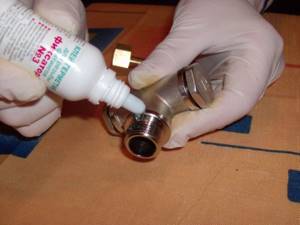
Application
During production, anaerobic sealants are packaged in plastic bottles of varying volumes. The dropper on the bottle allows you to quickly and conveniently apply the sealant to the surface.
Stages of applying glue:
- Degrease the areas to be joined and first remove dirt from them. Dry the surfaces thoroughly before applying glue.
- Shake the bottle well so that the composition inside becomes homogeneous.
- Apply glue to the surfaces to be joined and fix them in the desired position.
- Remove excess product with a rag.
- The composition hardens within 15 minutes.
The curing time depends on the size of the joint, the characteristics of the material and the room temperature. The gluing result will be of the highest quality if the sealant is applied to the entire bonded area of both parts, evenly distributed.
Tip Heat the parts to be glued if the temperature is below +15˚ C to speed up drying. At low room temperatures, the composition hardens slowly.
Even the most modern water pipes have threaded connections, as they also require high-quality sealing.
In the recent past, tightness was achieved using sealing threads, flax strands, and FUM tape.
The anaerobic sealants that replaced them protect metal surfaces from corrosion and provide excellent air and water tightness of threaded connections.
Many companies produce sealants; when choosing an adhesive composition, you should pay attention to some factors:
- what joint strength should be obtained as a result of gluing;
- the conditions under which the joints connected by the composition will be used;
- Will the part need to be disassembled later?
- thread characteristics.
Loctite sealant
The most popular anaerobic sealants on the Russian market are:
- Loctite (Loctite). Liquid compounds and sealing threads are produced under this brand. They are able to prevent gas or liquid leaks, increasing the strength of pipes several times. The cost of sealants from this manufacturer depends on their area of application and composition characteristics. For example, 50 ml of Loctite 577 universal glue costs on average 1,750 rubles, a 50 ml bottle of Loctite 542, used for small carvings, costs 1,784 rubles.
- Santekhmaster is a domestically produced glue from. The composition is resistant to antifreeze, gasoline, alcohol, and does not lose properties at elevated pressure and temperature. The product is used to seal threaded metal and flange connections, it is non-toxic and has no unpleasant odor. Prevents corrosion. A 15 g tube will cost at least 145 rubles.
- Anatherm is used to seal pores and cracks, fix threads when assembling parts and welds. As well as durable and very fast gluing of parts, repair and restoration of components and mechanisms. The cost of a 200 g bottle starts from 2400 rubles.
How to delete
It may be necessary to remove glue from threaded connections immediately after gluing or after the composition has completely hardened. In the latter case, you will need a hair dryer and a wrench.
Sealant removal steps:
- Turn on the hair dryer and direct a hot stream of air to the joint.
- Gradually the adhesive will begin to crumble, then remove the remaining sealant with a rag.
- Disassemble the connection using a wrench.
There is no need to completely remove the remaining adhesive; a new layer of sealant is placed on top of the old one without loss of effectiveness.
The best anaerobic sealants
What material is preferable to deal with? Let us turn to the study and rating review of the most popular domestic and foreign materials intended for sealing pipes.
Loctite 574
At a time when car manufacturers decided to combine the upper camshaft beds and the valve cover into one whole part, car mechanics began to speak extremely unflatteringly about them. The fact is that it is simply impossible to seal such a connection with a conventional gasket. The gap between these two planes should be no more than microscopic. Only an anaerobic composition can cope with such a task.
Loctite 574 is widely used by automobile manufacturers. He is considered to be the best of the best. But how could it be different when the price for a small bottle of the mixture is more than 2,000 rubles? This material retains the ability to polymerize in gaps up to 0.5 millimeters, but only after 24 hours. After treatment with this mixture, joints become suitable for work almost immediately. Naturally, only with slight pressure.
There is nothing negative to say about the durability of Loctite. Even motor oil at 125 degrees cannot affect its strength, no matter how long it is exposed to it. In addition, Loctite is resistant to automotive fluids such as gasoline and antifreeze. Of course, they can affect its strength, but only slightly.
Loctite 574
Advantages:
- excellent performance properties;
- long service life;
- ability to work in large gaps.
Flaws:
- high price tag.
The cost of Loctite sealant does not allow us to call it the best of the best sealants. It may well be replaced by an analogue that will have similar properties and cost much less.
Permatex 51813
Permatex is one of the most popular analogues of the anaerobic sealant Loctite. Perhaps, it became popular, first of all, due to its price - it is three times lower than the cost of the first. Another interesting fact is that from 1972 to 1999, Permatex was owned by Loctite.
The sealant was developed for joining parts made of aluminum, but it works just as well with steel and cast iron elements. The maximum gap is 0.4 mm, and the performance of the mixture is maintained even when heated to 150 degrees. It is also not afraid of liquids such as engine oil, gasoline and antifreeze.
The obvious difference between this sealant is the long polymerization time. It sets more slowly, so you will have to wait a little longer. But this problem can be solved. Permatex sells an activator that allows you to reduce polymerization time. Even with the purchase of a sealant and activator, the cost of Permatex remains significantly lower than Loctite.
Permatex 51813
Advantages:
- reliable connection of parts;
- Can be used to seal large gaps;
- durability.
Flaws:
- long time spent on polymerization.
Efele 133
The composition is of high quality, medium strength and high viscosity. Most often used for sealing pipe threaded connections whose size does not exceed 3''. The composition can be used for fixing pipe connections with threads up to M80 and with a gap not exceeding 0.5 mm. Efele 133 withstands prolonged vibration, shows high performance under high pressure, and can be used as a replacement for tape, winding, spring washer and similar mechanical means of fixation.
The material will not cause corrosion, is able to adhere to vertical surfaces, and will help prevent self-unscrewing and the ingress of water or aggressive compounds. At the same time, it is very easy to use. Copes perfectly with temperatures from -60 to +150 degrees.
Efele 133
Advantages:
- The optimum ratio of price and quality.
Flaws:
- not detected.
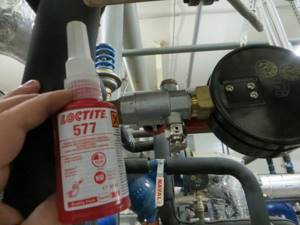
Loctite 577
Used for sealing pipes and fittings made of metal, as well as for other types of threaded connections.
Sealing occurs instantly. At the same time, the composition does not crumble or shift, and also shows high resistance to chemicals and high temperatures.
The composition hardens quite quickly and adheres well to gaps. However, this cannot be called an absolute plus. Due to rapid hardening, the ability to adjust the part is lost. In addition, its cost is quite high.
Loctite 577
Advantages:
- fast sealing;
- hardens quickly.
Flaws:
- price.
Loxeal 55-03
The composition is one-component and is used to seal bolts and nuts that require periodic dismantling. After use, the connection can be disassembled using ordinary tools.
Loxeal 55-03
Advantages:
- Reacts steadily to elevated temperatures, corrosion, prolonged vibration, and exposure to liquids, gas, and oil.
Flaws:
- not detected.
QuickSEAL 710
This anaerobic sealant is used to install gas, heating and water supply systems. It is designed to work with hydraulic systems and threaded parts made of metal.
One of the most important advantages is the presence of an anaerobic base. The principle of operation of this composition is the ability to displace oxygen accumulations from joints and fill all gaps, cracks and cavities.
But this is not the only advantage of QuickSEAL 710. It can be very quickly dismantled if the need arises. It has an easily dismountable degree of fixation of parts and can be used if necessary to seal connections on the following bases:
- brass;
- steel;
- zinc;
- cast iron;
- metal-plastic;
- chrome plated;
- galvanic.
QuickSPACER ® 710 complies with existing global standards. This allows it to be used when working with gas, water, compressed air and gasoline.
QuickSEAL 710
Advantages:
- After use, you can easily disassemble the part;
- strong;
- glues many surfaces.
Flaws:
- not detected.
Quickspaser 716
The composition has an average level of fixation. It is designed to perform tasks such as sealing and connecting threaded parts, and is resistant to vibration and linear expansion. Retains all its properties at temperatures that range from -50-150 degrees. This type of sealant is widely used in cases where it is necessary to seal connections when laying gas pipelines, water pipes and compressed air pipelines.
Quickspaser 716
Advantages:
- resistant to vibration and linear expansion.
Flaws:
- not detected.
SealUp
SealUp - showed excellent performance. It can be used for connections, joints and couplings when installing air conditioners and is capable of creating a film on the threads that is resistant to chemicals. Excellent for working with metal and plastic parts, withstands strong vibration and operates at temperatures of -90-200 degrees.
SealUp
Advantages:
- the composition retains elasticity;
- adheres perfectly to the surface;
- able to fill any microscopic cracks.
Flaws:
- not detected.
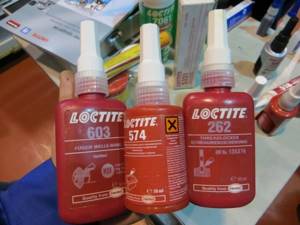
Schrauben Sicherung mittelfest
It is used in cases where it is necessary to prevent self-unscrewing of fasteners, which can occur due to high loads or strong vibration. In addition, it can be used in applications where it is necessary to seal threads or minor gaps to prevent corrosion. The bottle is only half filled.
Schrauben Sicherung mittelfest
Advantages:
- prevents corrosion;
- strong composition.
Flaws:
- not detected.
Manufacturers
You can argue for a long time about which manufacturer is better, so the simplest thing is to turn to reviews. Several brands receive the most positive ratings.
- Loctite. Universal glue from a Chinese manufacturer, however, many users noted that constant care of the cap is required.
- Sealup. Products from Italy are of high quality and easy to use. There is a guarantee seal, which stands out as an advantage, since it is possible to check how hermetically sealed the packaging is.
- Abro. One of the few sealants that can be used at negative temperatures - down to -20 degrees.
- Mannol. This option has one of the longest shelf lives, but it is impossible to work with it in a confined space due to the pungent odor.
- Wurth. This German-made fixative is considered to be of the highest quality. Despite the high cost, it is popular.
- Tangit Uni Lock. Manufacturer from Belarus. Specialized gels are produced for both plastic and metal.
- Siseal. Anaerobic gels of this brand are often used. Sold in containers of 100 g.
The best plastic sealants
LOCTITE VR 5921
A viscous pasty mass of red-brown color, emitting a characteristic alcoholic odor. When the solvent evaporates, a very strong and elastic compound is formed. Suitable for fittings, assemblies and flanges. A top quality product that has earned positive reviews and approval from experts. It is completely safe, has good efficiency when interacting with different surfaces, has a long shelf life, and does not lose its initial properties.
LOCTITE VR 5921
Advantages:
- strong and elastic connection;
- top quality product.
Flaws:
- not detected.
Sealants and sealants
To seal threaded connections use:
- tape and thread made of fluoroplastic sealing material (FUM);
- natural sealants (jute, tow);
- sealant pastes;
- rubber (polyurethane) sealing rings (RUK);
- cold welding.
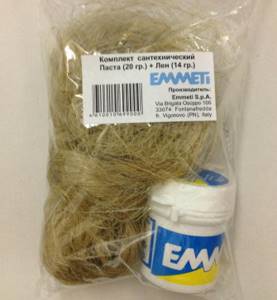
Plumbing kit - sealant and sealant


